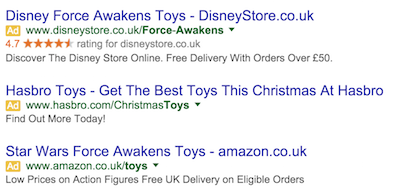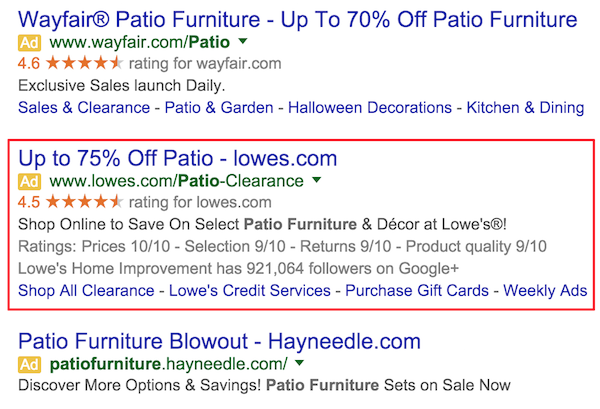Eight steps for an advanced PPC competitor analysis
The battle for leads, customers and revenue through PPC advertising is fierce and it’s getting harder and harder to differentiate yourself.
The battle for leads, customers and revenue through PPC advertising is fierce and it’s getting harder and harder to differentiate yourself.
What is your unique value? How do you separate yourself from the competition?
I’m not asking what you came up with in a marketing meeting, but what really makes you better than the competition from your customer’s perspective?
The battle for leads, customers and revenue through PPC advertising is fierce and it’s getting harder and harder to differentiate yourself.
You’re bidding on your brand terms and core keywords, but so are your top competitors. Often this leads to a bidding war, which we all know means higher CPC prices.

One way to gain an advantage and win the PPC battle is to conduct an in-depth competitor analysis, or what I call PPC competitor audit.
Analyze your industry or market by completing a competitor analysis, which allows you to evaluate your business against the competition. It will help you answer the following questions…
To gain insights that you can genuinely act upon, you need to see how you stack up against the competition.
Try to identify any opportunities or threats that need to be addressed. Conducting a deep dive into your direct competitors’ impression share, keywords, ads, landing pages, messaging, and offers gives you a better understanding of the marketplace and how you can improve your conversion funnel.
To help with this, I’m sharing my eight-step process to audit the competition and gain an advantage. An approach based on my experience in the PPC advertising space.
The first step is to clearly define what you do, what problem you solve and why are you are in business.
Take a moment for some company self-reflection by asking yourself….
Keep in mind that what you think you’re selling may not actually be what you’re selling from the customers’ perspective. For example, alarm system companies seemingly sell alarm systems, but actually they sell peace of mind.
So take a moment to write down exactly what you sell from the customers’ point of view. Also take a moment to write down what makes your business unique and why you stand out from the competition.
Do you have the best prices, best customer service or do you offer something unique in your industry? Do you offer anything the competition doesn’t have?
Step one consists of a self-reflection exercise where you document what your business does and what makes your company special or unique.
Next up, marketing 101 class, have you specifically defined your exact target market or ideal customer?
In B2C you want to answer the following questions:
If you’re selling to B2B companies you need to answer questions like:
Overall, the most important part of this step is making sure you define your target market as specifically as possible.
You also want to focus on your ideal, most profitable customer so you know exactly who you should be targeting and prioritize efforts that get you in front of those ‘best customers’.
One mistake people make is thinking, “Our target customers are companies with X employees in Y and Z industries, but we also don’t want to miss smaller companies in different industries.”
The problem with this thinking is that instead of focusing your marketing efforts on ideal customers who will make up 80% to 90% of your customer base, you’ll end up focusing on ideal customers and customers outside of your target market who are much less likely to make a purchase. This waters down your marketing effort and diminishes the results.
It’s much better to focus on your ideal most profitable customers and accidentally pick up some customers who are outside of that list, rather than focusing on everyone who could possibly buy your product, without focusing on the people who are the most likely to make a purchase.
Total Addressable Market (TAM) is good to show investors but too broad to target everyone, get specific and use these five PPC keyword research tools.
Price isn’t everything, but it is very important. Once you have clearly defined your target market, take some time to conduct a competitor price comparison.
This step is to see where you fall in the marketplace so you know how to position yourself and where your business fits in the pricing spectrum: lowest, medium, highest priced.
For example, is price an advantage for you because you’re a discount service provider? Or are you premium-priced which means you need to justify to customers the value and specifically why you are more expensive.
Either way, conducting a price-comparison analysis helps you to know where you are in the market and how you can use that to your advantage.
One thing to keep in mind is that you may need to request pricing directly from competitors. Not everyone has their prices advertised on their website, which means you may need to conduct a secret inquiry to find out how much their service or product costs.
Understanding the marketplace pricing range helps you adjust and fine tune your messaging strategy accordingly.
Step four consists of analyzing each competitor’s unique value propositions (UVP) with the goal of seeing how yours compares to the competition.
Take a moment to visit your competitors’ websites and to write down their UVPs. If they have one.
In case you need a refresher on what a unique value proposition is, here’s a definition:
A unique value proposition is a concise statement explaining what benefit your customers will experience from using your product or service while also demonstrating what makes your business unique.
One well-known example is GEICO because you know that you’ll save money by signing up.
They aren’t promising the most comprehensive insurance in the world, but they do promise great rates. “…See what you could save” or “15 minutes can save you 15%.”

BMW sits on the other end of the spectrum with a unique value proposition that tells customers that BMW builds the ultimate driving machine.

This helps them stand out from less expensive cars while also positioning them uniquely next to other luxury cars like Mercedes and Lexus.
Keep in mind that a unique value proposition is different than a tagline or a homepage headline but should be communicated through both the tagline and headline.
An important function of a value proposition is to create an emotional attachment to your brand and to capture what makes your product or service unique and valuable.
In order to figure out your own unique value proposition, you need to know your competitors’ UVPs, so take a moment to write those down now.
Once you’ve done that, write your current unique value proposition down. You may need to change it later, but for now, write it down and save it.
Another important step is to study your competitors’ ad copy variations.
Take notes on what ad extensions they’re using and what ad copy they’re writing in order to stand out.
You also want to pay attention to whether or not they’re running special offers or discounts to entice searchers to click through.
Take some time to analyze the SERPs because this is where a big part of the battle will either be won or lost.

You especially want to take notes on what it takes to stand out and what it will take to have the strongest or one of the strongest offers in the SERPs.
If you’re already doing PPC and bidding on AdWords terms, you can go into Auction Insights under details to see what your impression share is and where your competitors show up.

You can also use a keyword tool to evaluate each competitor you are bidding against and quickly see their top keywords, what ads they’re running, and what landing pages they’re directing traffic to.
Too many people look at competitive intelligence in keyword and ad silos. I like to look at competitive intelligence from the users’ perspective by comparing my conversion funnel to the competition.
Not only do you want to look at what keywords and ad copy variations competitors’ are using, but you also want to take a look at their landing pages.
How are they converting they’re traffic? Are they offering a free guide or a discount to people who click through from Google?
Pay close attention to what competitors are doing in terms of ads, landing pages and calls to action. Take notes on anything that will help you improve your landing pages or ideas to test new ads.
Now that we’ve conducted our in-depth competitor analysis, let’s go back to your UVP to see how it looks.
Does it convey a value proposition that communicates why people will get value out of using your service? Is it unique? Will it stand out enough in the marketplace?
Take a moment to review your UVP with these questions and your competitor analysis in mind before deciding whether or not it needs to be improved or whether or not it’s okay as it is.
After you’ve reviewed your UVP, do the same with your PPC campaigns.
Are there keyword groups you discovered that competitors are bidding on that you’re not?
What about your ad copy, is there something you can change or a new offer you can run to better compete?
Take a look at your entire conversion funnel in light of the competitive analysis you’ve conducted to see where it can be improved and how your offers, messaging, and keyword grouping can become more competitive.
The final step, now that you’ve applied what you learned to your website and PPC campaign, is to continue monitoring your competition.
It’s possible that your competitors’ will launch a new product or feature set, change their prices, or update their messaging and unique value proposition.
This means you need to constantly monitor your competition so you’re the first to know when they make a change. When possible, it’s best to use competitive intelligence tools to automate this process so you don’t have to manually track competitors yourself.
Using campaign watch software you can see which competitors have launched new ads or landing page offers and how ads look on the Google search engine results page SERPs from different times and locations.
This wraps up my eight step guide to an advanced competitor audit. Let me know if you would add any other steps or share how you use competitor intelligence.